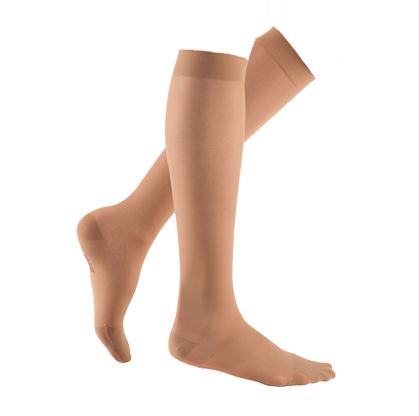Compression Stockings
Compression stockings are often confused with the term support stockings. However, there is a difference between compression stockings and support stockings. Unlike compression stockings, normal support stockings are worn preventively. This has a beneficial effect on blood circulation in the legs and reduces the risk of varicose veins.
Compression stockings, also known as therapeutically elastic stockings, can offer a solution if you suffer from severe oedemic formation, varicose veins, before and after vein operations, tingling, cramps, fluid retention or heavy and tired legs. By exerting pressure from outside:

- Blood vessels are supported
- Blood flow is improved
- Better moisture removal
In addition to functionality, we also attach importance to the aesthetics of support stockings. There are therefore many trendy and fashionable support stockings in various designs, colours and thicknesses. Together, we also try to find the ideal stocking that meets your physical requirements, but also the comfort of your daily life.
In our frequently asked questions section you can find more information and tips about the use of support stockings.
-
How are support stockings measured?
When to wear support stockings?
With support stockings, a subdivision is made into 4 classes based on their pressure value. This is an overview of the 4 classes with the most common medical conditions:
Class 1 : These compression stockings give a light pressure with a superficial drainage system of moisture and waste. This class applies for/to people with:
- heavy and tired legs,
- a light form of varicose veins,
- preventive wear during pregnancy,
- a slight tendency to oedema
Class 2 : These compression stockings provide moderate pressure with a superficial drainage system of moisture and waste. This class applies for/to people with:
- varicose veins,
- swollen legs during pregnancy,
- operations of varicose veins,
- a treatment of vein problems,
- a slight tendency to oedema
Class 3 : These compression stockings provide a strong pressure with a superficial and deep drainage system of moisture and waste. This class applies for/to people with:
- varicose veins due to damaged deep veins,
- chronic venous insufficiency,
- early stage lymphoedema,
- a strong tendency to oedema
Class 4 : These compression stockings provide a very strong pressure with a superficial and deep drainage system of moisture and waste. This class applies for/to people with:
- very severe venous diseases,
- advanced lymphoedema.
Repayment of Support Stockings
Support stockings are subdivided into 4 classes based on their pressure value. In the case of specific medical problems such as lymphedema or chronic venous disorders, or on the prescription of a medical specialist, the health insurance fund can partially or fully help you with the purchase of support stockings.
- • With lymphoedema there is a reimbursement for:
- class II up to 15 years,
- class III + IV older than 15 years.
You are entitled to 2 support stockings per leg per 6 months.
- With chronic venous diseases, there is a reimbursement for:
- class II up to 15 years,
- class III + IV older than 15 years.
You are entitled to 2 stockings per leg per 12 months.
To find out which class you are in, you can look at frequently asked questions..
With regular support stockings, sports compression stockings and travel stockings there is no reimbursement from your health insurance fund.
All information that you can find about reimbursements is not definitive. We therefore recommend that you always contact your own health insurance fund regarding reimbursements.
Different types of support stockings
Compression stockings
Compression stockings or therapeutic elastic support stockings do not provide the same pressure everywhere. The pressure is greatest at the ankle and gradually decreases to the top, so that moisture and waste can be removed better. To obtain the correct size and correct pressure, compression stockings must be measured. Depending on the amount of compression, the stockings are subdivided into different classes.
Normal support stockings
Normal support stockings provide the same amount of pressure over the entire leg. In contrast to therapeutic stockings, the pressure on support stockings is much lower. These support stockings are mainly used for tiredness or leg cramps and, as the word suggests, provide extra support.
Diabetes stockings
When you have diabetes, your feet are quite vulnerable. As a result of the damage to the nervous system and blood circulation, certain wounds are noticed too late, causing them to heal more slowly or even infect. Diabetes stockings are seamless, which reduces the risk of wounds.
Sports compression stockings
Sports compression stockings are used in sports, such as cycling, running, football, basketball and many other sports. These compression stockings provide injury recovery, injury prevention and a reduction in muscle pain and cramps.
Travel stockings
When you have to sit still for a long time during a flight, train or car trip, travel stockings are often recommended. Due to a lack of exercise, there is an increased risk of blood clots. A combination of wearing travel stockings and regular exercise prevents the formation of these blood clots.





